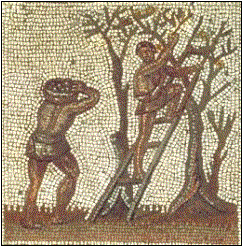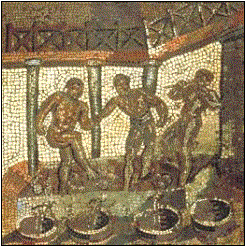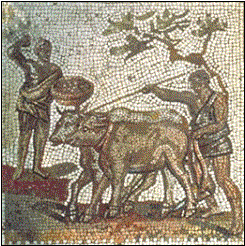Slave-owning mode of production
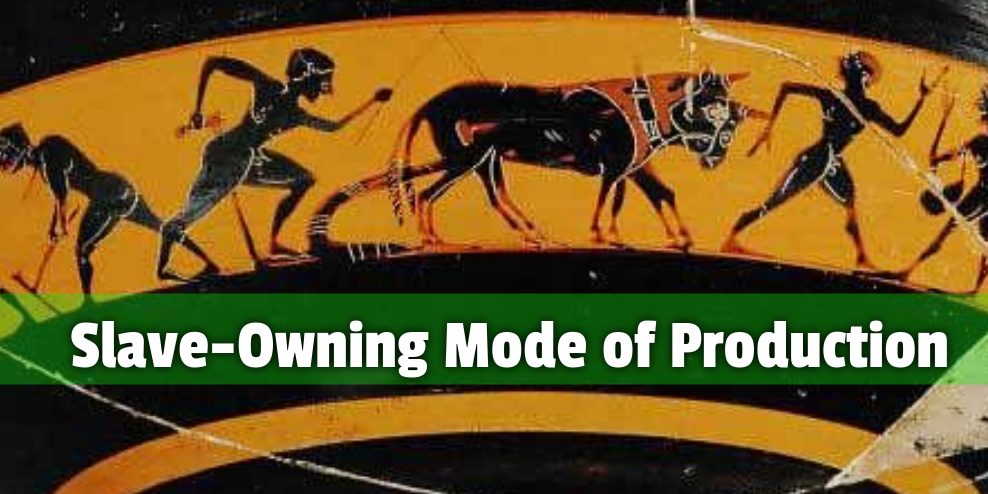
Slave-owning mode of production. Mode of production based on the physical ownership of most of the labor force by the exploiting class within the framework of an economy which is only very partially commodified.
General characteristics of the slave-owning mode of production
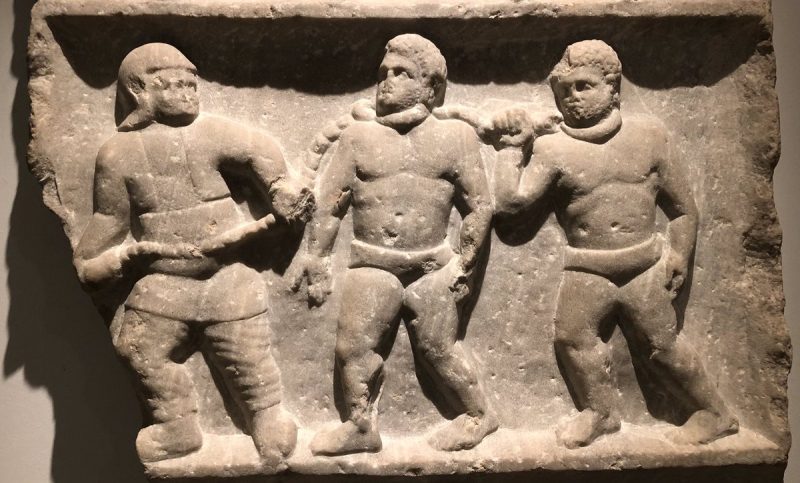
Roman legionary leads vanquished men bound in chains. The slave-owning mode of production will require continuous conquests to maintain a sufficient number of slaves for its productive needs.
The slave-owning mode of production spread throughout the ancient world from Hindustan to the Atlantic, sweeping or transforming civilizations based on the asiatic mode of production. In Europe it lasted until the fall of the Roman Empire and the development of feudalization, in the Middle East until the spread of Islam and in much of Africa until the 19th century. Under this mode of production the state develops further, the great empires of the West appear (from Persia to Africa), the first great commercial networks appear, as well as the complex legal systems and the great ideological apparatuses of Antiquity.
Its main defining elements are:
- The majority of the workforce - and of the population - is owned by the families of the exploiting class and, to a lesser extent, by the state. The exploitation is personal and direct and the worker, individually, has the consideration of an object, just like any other means of production. The slave is not however a commodity, he is not produced to be sold (as would happen under US slave-owning capitalism) and his transmissibility or emancipation will depend on his position in the productive apparatus and the situation of his owner.
- The buying and selling of the principal means of production, the agricultural and mining properties with the slaves bound to them, is relatively rare and is highly regulated and ritualized. Normally restricted to the ruling class and at the very least to non-foreign "free men".
- A mercantile economy develops with large commercial circuits strictly in the hands of the ruling class and the state. These commercial circuits will also be limited in their growth since the majority of the population - the slaves - cannot even go to the market if not on behalf of their masters.
- War and territorial expansion fulfill a double economic function: on the one hand to capture slaves in order to alleviate the high cost of reproduction of these, on the other to increase the land under production by alleviating the tensions between the ruling class and the other free classes.
- The state develops complex institutions and mechanisms -legal, political, ideological and welfare- to dampen the conflict between free classes and repress both the few slave uprisings -true obsessive panic of the ruling classes- and the cyclical revolts of subjugated peoples and tribes that, with productive systems based mostly on communal land ownership, will refuse to pay exactions.
Class structure of the slave-owning mode of production
Scenes of agricultural labor in the slave-owning mode of production
The nobility of the slave-owning mode of production is usually reminiscent of a conquering people or tribe or a fusion of several. It monopolizes the ownership of land and the leadership of the state and its ideological and bureaucratic apparatuses. It is internally hierarchical and stratified to varying degrees. Alongside it will appear in most cases a heterogeneous plebeian class that will push for access to land ownership and the ability to gain leverage in the state.
The slaves will form the bulk of the exploited class, the majority in society. Their origin in the conquered tribes and peoples is evident in Sparta. There the city - that is, the political structure of free families - is the collective owner of the helots, to whom it declares war annually so the latter lose human consideration and can be killed without constituting a crime against property. Thanks to Thucydides we can deduce that the helots maintained certain forms of communal exploitation of the land and matrimonial rights.
The state of permanent class warfare and the consideration by Thebans and Athenians of the helots as a subjugated people and not as mere slaves, reveals however that Sparta never finished establishing the slave-owning mode of production, which would not fully develop until the Roman conquest. However, precisely for this reason it shows the permanent tension that, more or less symbolized, will underpin the slave state against the exploited class during its entire historical trajectory.
The class struggle under the slave-owning mode of production and the emergence of feudalism
However, the few, though always threatening, slave revolts could not be the reason that brought the slave-owning mode of production to its knees, but rather the confrontation between nobility and commoners for access to the ownership of new lands and labor to exploit.
The relatively low productivity of the land and the high cost of reproduction of slaves forced at different times, for instance in the mining operations of the Roman Republic in Baetica and Gallia citerior, to resort to wage labor. However, the scarce commodification of the means of production, the demographic scarcity of subjugated "free peoples" and the absence of a developed commercial bourgeoisie - long-distance trade was in the hands of the nobility and state bureaucracy - made impossible the emergence of circuits of capital accumulation.
However, still under the rising period of the slave mode of production, with different forms according to the civilizations, the figure of the colonate will appear: large amounts of assimilated nomadic peoples and freed slaves who are bound to a land that they cultivate - generally under a communal regime and as subsistence agriculture - in exchange for an income.
The colonate serves to overcome the conflict with the landowners of the interior - commoners turned landowners - and to recover the tax revenue at a time of weakness and political fractioning. Not only because it serves to put new areas into production, but also because the taxes will be collected directly from the colonists, not from the landowners, and it is always easier to collect taxes from an atomized and geographically isolated exploited class than from a proprietor class which organizes social work in a region with little presence of coercive forces of the state.
The extension of this system during the decadence of the slave-owning mode of production - in Rome it became regulated from the 3rd century onwards - is a response to a basic tendency towards depopulation and lack of new slaves, materialized in the first place as a fiscal crisis... and therefore as a urban crisis. That is why it will interest in the first place a part of the nobility and the peripheral bureaucracy.
The commoners who had benefited from the distribution of lots and land for military services or as a relief from urban class tensions, will thus become landowners and exploit a labor force legally free but bound to an agrarian property from which they will not be able to leave.
The colonate actually prefigures feudalism within the slave-owning society during its decadence. The arrival of the barbarian invasions will assimilate the interests of this new class of agricultural landowners to those of the new invading nobility against the state apparatus of the cities, bringing about the definitive change in the mode of production.
http://dictionary.marxismo.school/Slave-owning mode of production